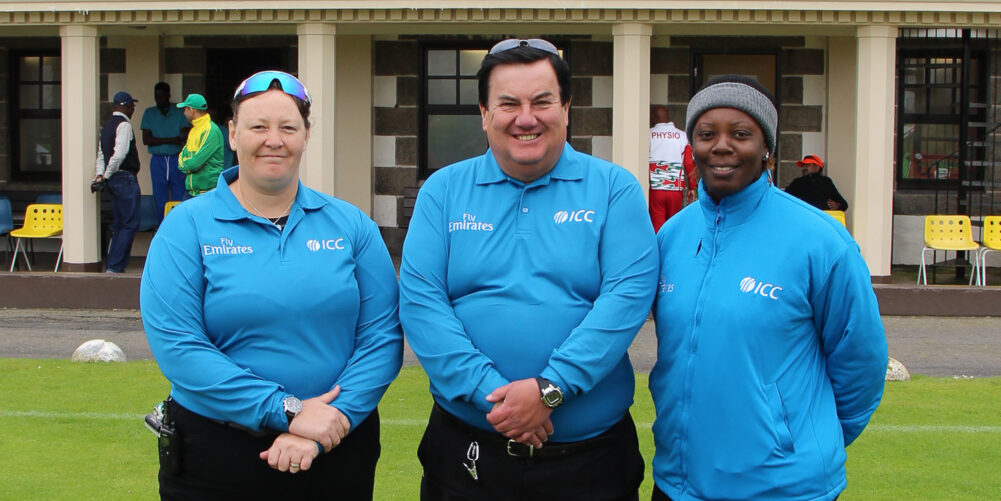Rarely has this column sought out a particular scorecard from ICC World Cricket League Division 5. However, there are two points of interest to note from a match between Oman and Nigeria, played at the St Clement ground in Jersey in 2016.
The most obvious fact to stand out from the scorecard is that not one Nigerian batsman reached double figures. Batting second in the 50-over contest, they were rolled over for 39 inside 23.5 overs. The total, however, wasn’t even the lowest in the history of the WCL.
The second point of interest is less obvious, but rather more significant. Glance down to where it says ‘Umpires’, and alongside the name ‘AJT Dowdalls (Scotland)’ it lists ‘S Redfern (England)’. Below, it records the third umpire as ‘JM Williams (West Indies)’. The ‘S’ in Redfern stands for Sue while the ‘J’ in Williams is Jacqueline.
Two females were officiating a men’s ICC tournament match – something which had never happened before. Whilst New Zealander Kathy Cross, a member of the ICC’s Associates and Affiliates Panel of Umpires since 2014, had begun paving the way in international men’s cricket by standing in WCL Divisions Five and Three in Malaysia that year, this was the first time two females had officiated at this level together.
Redfern and Williams went on to stand in the ICC Women’s World Cup Qualifying tournament earlier this year in Sri Lanka, alongside Cross and Australian Claire Polosak, a pair who had featured together at the ICC Women’s World T20 in India in 2016. The four women officiated alongside five male colleagues, and together, they are the most senior female umpires in the game. Cross is the most experienced, having switched from playing to umpiring in 1998, and being heavily involved in New Zealand’s domestic men’s scene. She has been umpiring women’s internationals since 2000.
Polosak and Williams had their first experience of women’s internationals in 2015, having started to gain experience of officiating men’s professional domestic cricket in their respective countries, too.
Redfern estimates she spends between 50 and 60 days per year officiating in England at various levels under the auspices of the ECB. A former England bowler, she combines her umpiring career (or ‘hobby’ as she calls it) with a role at the ECB as Clubs and Facilities Manager for the East Midlands.
She was previously the ECB’s Inclusion and Diversity Manager, and before that the National Development Lead for Women’s Cricket. Now she could be officiating in men’s, women’s or even indoor cricket in the winter.
“Obviously I work full time as well,” she says. “It’s a hobby, it’s a passion, and I spend a fair bit of time out there trying to improve myself as an umpire and standing in different levels of the game to get different experiences.”
While Redfern played six Tests and 15 ODIs for England between 1995-1999, her route into umpiring and her experience of the game is very different to Polosak’s, who is a teacher by profession and never played any cricket, despite loving it. Polosak’s pathway is important to show other potential umpires that you don’t need to have played the game in order to be able to understand, appreciate and apply the Laws as an official.
“All four of us have had very different experiences as to how we got into cricket and officiating,” Redfern explains. “I’ve been fortunate to play international cricket but there are people who get into officiating simply through an interest in the game and wanting to do something within it. When I stopped playing I wanted to stay involved and wanted to give umpiring a go but there are a variety of backgrounds that lead to officiating.”
“Any woman who wants to officiate can contact their local board,” says Redfern. “You can feel confident that if you go on the basic course for officials it will teach you all about the game. So if you haven’t got a huge amount of playing experience, it will give you an opportunity to get into it.”
Redfern estimates that 95 per cent of her umpiring is done in men’s cricket, which is more due to the number of matches available than anything else.
“I feel passionate about the women’s game and the participation and growth that is being experienced in women’s cricket, but there are just more matches in men’s cricket at the moment with the volume of teams. So there is more opportunity. For me though it’s about doing a mixture. I love doing the women’s game for different reasons to the men’s, and it all gives me different experiences.”
It is inescapable that Redfern would have attracted more curiosity on her umpiring debut than she would have done if she was a man. However the 39-year-old prefers to focus on the fact that it takes any new umpire time to earn the respect of the players, whatever your gender.
“I was very fortunate,” she says. “I got lots of support from my local county association. But like any new umpire it’s a new challenge. Players don’t know you, but as you officiate with them more, as I have over the last five years, they start to recognise who you are and they base your performances on what you do on the field.
“I just want to be seen as an umpire and I want to be the best umpire I can be. It’s not about me being a female, it’s about me being a good umpire.”
The ECB say they have over 150 qualified female umpires, and the Association of Cricket Officials will be using the visibility of the Women’s World Cup in England this summer as an opportunity to try to significantly increase their membership.
Last year Redfern was joined by two other women in officiating men’s County 2nd XI cricket for the ECB; 53-year-old Alison Smith, from Buckinghamshire, and 52-year-old Ingeborg Bevers, of Worcestershire (originally from the Netherlands). Redfern knows that more women need to be seen doing tasks that are traditionally male in order for perceptions to change and for other women to realise there are opportunities in that regard.
“I think it’s similar to what we’re experiencing across the world in terms of the number of female players. It will be natural that the more visible it is and the more women are interested in and involved in cricket, the more likely it will be to increase coaches and umpires alike.”
Compared to the number of volunteer umpires operating at all levels of the sport, there are only a small number of full-time professional umpiring jobs in world cricket.
However the ECB and ICC pathways are in place for both men and women equally, so if Redfern or any other female wanted to choose the life of an elite umpire and set out to rise up the rankings, is it conceivable that one day a woman could stand in a men’s Test match?
“There is no reason why a woman can’t stand in a men’s Test match in the future,” she states emphatically. “It should be about an umpires’ performance, not their gender. It’s important that women are given the same opportunities as men, and if they’re good enough, why not.”
Incidentally, Oman finished runners up in WCL Division 5 after beating Nigeria so convincingly last year. They were then promoted from Division 4 and will now compete in the Division 3 tournament in Uganda next month. Redfern’s career and that of her colleagues, is similarly on the up.
This piece originally featured in The Cricket Paper, April 21 2017
Subscribe to the digital edition of The Cricket Paper here












